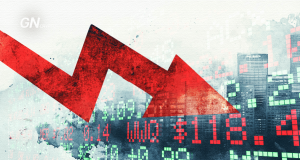What the .io Domain’s Fate Means for Crypto Projects

As the geopolitical situation around the British Indian Ocean Territory evolves, the stability of .io domains, widely used in the crypto world, is under scrutiny. Learn about the potential risks, alternatives like .crypto, and how AI-focused domains like .ai are gaining traction.
On this page
- The Rise of .io: A Domain That Became a Crypto Standard
- The Controversial History of the Chagos Islands and .io’s Dark Past
- What Happens When a ccTLD Faces Retirement
- Lessons from the .su Domain: A Precedent for Geopolitical Domain Risks
- Enter the Contender: .crypto and the Future of Decentralized Domains
- The Stability and Rise of .ai for AI Startups
- Other Domains in Crisis: Lessons from .ly and .ir
- What Happens When a ccTLD Faces Political Risk
- Comparing .io, .crypto, and .ai in Terms of Stability
- The Future of Domains for Crypto Startups
In the fast-paced world of cryptocurrency, domain names are more than just technical addresses—they are central to a project’s identity, signaling innovation and trust. Among the many domain extensions available, .io has become a standout choice for tech-savvy and blockchain-based projects. Originally tied to the British Indian Ocean Territory (BIOT), .io has become emblematic of the tech and decentralized finance (DeFi) communities, but its future is now uncertain.
Geopolitical shifts involving the Chagos Islands and the BIOT are raising serious concerns about the stability of .io domains. This has prompted many crypto projects to weigh the risks of continuing with .io against the potential benefits of switching to alternatives like .crypto, which align more closely with the decentralized ethos of blockchain. For companies exploring artificial intelligence (AI), .ai also presents a more stable option.
As the landscape of domain names evolves, what does the future hold for .io and the many crypto projects that rely on it?
The Rise of .io: A Domain That Became a Crypto Standard
The .io domain was introduced in 1997 as the country code top-level domain (ccTLD) for the British Indian Ocean Territory, a small archipelago in the Indian Ocean. Initially, .io was just a geographical marker, but over time, it evolved into much more. Tech startups and blockchain projects gravitated toward .io for its sleek, modern sound and its association with the computing term input/output (I/O), which refers to data exchange in technology systems.
One reason .io gained such traction in the tech world was its availability. When .io domains first became accessible in 1997, there were far more domain options available compared to more established domain extensions like .com. This gave companies the flexibility to register meaningful and memorable domain names, which is crucial for branding.
Why .io Appeals to Crypto Companies
For blockchain and crypto projects, branding is everything. The domain name reflects a project’s identity, and .io quickly became a symbol of innovation, modernity, and cutting-edge technology. Its association with Web3, DeFi, and blockchain technologies was a natural fit. The .io domain was a favorite among developers and startups looking for a domain that conveyed a forward-thinking, tech-savvy image.
Additionally, .io offered a more affordable alternative to the premium .com domain, which is often out of reach for new projects due to cost. Google also treats .io as a generic top-level domain (gTLD) rather than a ccTLD, which benefits companies seeking global search visibility.
This makes .io particularly attractive for crypto startups that want to reach a broad, international audience.
Some of the most notable examples of .io domains in the crypto space include Uniswap.io, a leading decentralized exchange, and Etherscan.io, a blockchain explorer for Ethereum. Other popular .io domains include Gate.io and Cointraffic.io, which have cemented .io’s role in the crypto ecosystem.
Interestingly, the popularity of .io even extended beyond the tech world. In 2016, Marco Rubio used the domain rub.io during his US Presidential campaign. Similarly, Hillary Clinton’s campaign team used a .io domain for link shortening, highlighting its appeal across industries.
The Controversial History of the Chagos Islands and .io’s Dark Past
While .io gained popularity in the tech and crypto spaces, its origins lie in a far more complex and controversial geopolitical history. The British Indian Ocean Territory (BIOT), which governs the .io domain, was formed in 1965 when the UK forcibly detached the Chagos Islands from Mauritius. The UK’s primary goal was to establish a US military base on Diego Garcia, the largest of the islands.
SOURCE: Diego Garcia – BBC – Google Earth
This detachment came at a significant human cost. More than 2,000 Chagossian people were forcibly removed from their homes with minimal compensation. These islanders were displaced to Mauritius and the Seychelles, where they have been fighting for their right to return ever since.
The Chagossians have taken their case to courts around the world, including the European Court of Human Rights.
In 2019, the International Court of Justice (ICJ) ruled that the UK must end its administration of the islands and return them to Mauritius. The UN General Assembly subsequently endorsed this ruling.
Finally, on October 3, 2024, the governments of the UK and Mauritius reached an agreement to transfer full sovereignty of the Chagos Islands to Mauritius, while allowing the US military base to continue operating for another 99 years.
The Prime Minister of Mauritius has called the expulsion of the Chagossians a “crime against humanity,” and there has been discussion of bringing charges against the UK. While the immediate implications of this political shift for the .io domain are unclear, the long-term effects could be profound.
SOURCE: Diego Garcia Map – BBC – Google Earth
If Mauritius assumes control of the BIOT, it is likely that the administration of .io domains will also transfer, potentially leading to new regulations, price changes, or even restrictions on domain registration.
What Happens When a ccTLD Faces Retirement
One of the major concerns surrounding the .io domain is what will happen if Mauritius takes control of the BIOT and decides to make changes to the .io registry. In the worst-case scenario, the .io domain could be retired altogether, forcing crypto projects to migrate to new domains.
When a ccTLD is retired, it is typically because the country or code has been removed from the ISO 3166-1 alpha-2 standard. According to the Internet Assigned Numbers Authority (IANA), when this occurs, the operator is expected to develop a transition plan to phase out the domain over a period of several years. This process allows companies to migrate to a new domain, but it is not without risks.
According to the Internet Assigned Numbers Authority:
When a ccTLD is no longer eligible, typically due to the country or code’s removal from the ISO 3166-1 standard, the operator is expected to develop a transition plan… and ultimately retire the domain.
Also stating that:
…the manager is expected to design and execute a method of notifying impacted registrants that the domain is to be retired, and develop a timeline to transition…
But domain migration can lead to the loss of backlinks, SEO rankings, and brand recognition, all of which are crucial for businesses that rely on online visibility. Furthermore, companies that use .io would not be able to redirect traffic from their old domain to their new one, meaning they would have to start from scratch.
The transition process can be complex and costly, especially for crypto projects that operate with large communities and billions of dollars in assets tied to their platforms. Additionally, there is little in the NIC.IO legal documentation about what would happen in the event of ccTLD retirement, aside from a general statement that NIC.IO is not liable for any loss of profit or business.
Lessons from the .su Domain: A Precedent for Geopolitical Domain Risks
The potential downfall of .io is reminiscent of the .su domain, which was introduced in 1990 as the ccTLD for the Soviet Union. When the USSR collapsed in 1991, .su technically became obsolete, but Russia has continued to allow registrations under the .su domain, even though the Soviet Union no longer exists.
While .su remains in use today, it exists in a legal gray area, and many businesses avoid it due to its uncertain status. The .su domain highlights the risks of relying on a ccTLD that is tied to a politically unstable region. If Mauritius takes control of the BIOT, .io could face a similar legal limbo, with the possibility of new rules, price changes, or restrictions on registration.
Enter the Contender: .crypto and the Future of Decentralized Domains
As concerns about .io’s future mount, .crypto is emerging as a promising alternative for blockchain projects. Unlike traditional domains, .crypto is a decentralized domain extension built on blockchain technology. This means that .crypto domains are not governed by centralized organizations like ICANN. Instead, they are owned by the users themselves, providing censorship resistance and eliminating the need for intermediaries.
.crypto domains are managed as non-fungible tokens (NFTs) on blockchain networks like Ethereum and Zilliqa, ensuring that ownership is permanent and cannot be revoked by any central authority. Additionally, .crypto domains can also function as wallet addresses, allowing users to send and receive cryptocurrency directly through their domain name.
However, .crypto is still in its early stages, and its adoption is limited by technical barriers. Traditional web browsers do not yet support .crypto domains by default, meaning users must rely on browser extensions to access them.
Nonetheless, as Web3 infrastructure evolves, .crypto…could become the go-to domain for decentralized platforms. As Web3 continues to grow, the adoption of .crypto could transform the way blockchain projects manage their online presence.
The Stability and Rise of .ai for AI Startups
While .io and .crypto dominate the blockchain conversation, .ai has quietly gained traction as a stable domain option for AI startups. Tied to the small Caribbean nation of Anguilla, .ai has become the domain of choice for many artificial intelligence companies, including OpenAI and Hugging Face.
The .ai domain offers a significant advantage: political and regulatory stability.
Unlike .io, which faces potential geopolitical risks, .ai is backed by the Anguillan government, which relies on domain revenue as an important part of its economy. This ensures long-term stability for companies using .ai, making it a more attractive option for businesses concerned about the future of their online identity.
AI-focused companies like Stability.ai and Alethea.ai have adopted the domain as part of their brand, emphasizing their connection to cutting-edge technology. The stability of .ai, combined with its alignment with the artificial intelligence sector, makes it an ideal choice for companies in the AI space.
Other Domains in Crisis: Lessons from .ly and .ir
.io isn’t the only domain facing potential geopolitical instability. Similar challenges have arisen with other ccTLDs like .ly (Libya) and .ir (Iran). During the Libyan Civil War, the .ly domain—most notably used by URL-shortening service bit.ly—faced disruption as the political situation in Libya deteriorated.
Many companies were forced to migrate to more stable domains.
Similarly, .ir, the domain for Iran, faces ongoing challenges due to international sanctions and geopolitical tensions. Websites using .ir domains can be restricted from international transactions, making it difficult for companies to operate globally. These examples show that ccTLDs tied to politically unstable regions can put businesses at risk, reinforcing the need for stable domain options.
What Happens When a ccTLD Faces Political Risk
The potential transfer of control over .io to Mauritius could have far-reaching consequences for the tech and crypto projects that rely on the domain. If Mauritius decides to implement changes, such as price hikes, new regulations, or restrictions on non-resident registrations, many companies will be forced to migrate their online presence.
In 2012, Mauritius refused to renew an agreement for the management of its .mu domain, leading to a dispute with the administrator and disruptions to the .mu registry. Similar issues could arise with .io if Mauritius decides to take control of the registry. Although unlikely, ICANN’s former General Manager of Public Participation Kieran McCarthy has noted that it is “not inconceivable” that the .io registry could be scrapped altogether.
The Internet Assigned Numbers Authority (IANA) states that when a ccTLD is no longer eligible, the operator must develop a transition plan to notify registrants and allow them time to migrate to a new domain. Typically, this process takes several years, but the financial and logistical costs of such a migration can be significant.
Comparing .io, .crypto, and .ai in Terms of Stability
When comparing .io, .crypto, and .ai, the key difference lies in the risk profile and regulatory stability of each domain.
- .io remains a strong choice for now due to its widespread use in the tech and crypto space, but its ties to the politically unstable British Indian Ocean Territory raise significant concerns.
- .crypto offers the benefits of decentralization, making it attractive to blockchain projects that prioritize independence from centralized control. However, its early-stage adoption and technical hurdles—such as the need for browser extensions—remain obstacles to mainstream use.
- .ai provides political stability and a clear governance structure, making it an ideal choice for tech companies seeking long-term security.
For companies that operate at the intersection of AI and blockchain, .ai offers the best of both worlds: a stable domain environment and a clear association with cutting-edge technology.
The Branding Power of Domains
Beyond the technical considerations, domain names play a critical role in branding. For crypto and tech companies, choosing the right domain can make or break their brand image.
- .io has become synonymous with innovation in the tech space, offering instant credibility for companies looking to establish themselves as part of the blockchain and Web3 ecosystem.
- .crypto represents more than just a domain—it symbolizes a commitment to decentralization and freedom from centralized control, aligning closely with the ethos of blockchain projects.
- .ai signals a company’s focus on artificial intelligence, instantly conveying their expertise in machine learning and automation technologies.
Each domain offers unique branding opportunities, and companies should carefully consider their long-term goals when choosing a domain.
The Future of Domains for Crypto Startups
The domain landscape for crypto and tech startups is rapidly evolving. As geopolitical risks and regulatory pressures increase, companies must carefully evaluate their options when choosing a domain. While .io remains a dominant force in the blockchain world, its uncertain future could drive companies to explore alternatives like .crypto and .ai.
The potential retirement or restriction of the .io domain would have serious implications for crypto projects. These companies are not just websites—they are ecosystems with large communities and billions of dollars in assets. A forced migration from .io to another domain would involve significant financial costs and potential losses in SEO rankings, backlinks, and brand recognition.
Ultimately, the choice between .io, .crypto, and .ai depends on the project’s priorities. Companies that value immediate recognition may stick with .io for now, while those seeking decentralization may migrate to .crypto. For AI-driven projects, .ai offers long-term stability and clear branding advantages.
Since the IANA had also kept the .yu domain operational for years after the dissolution of Yugoslavia, it’s highly likely that there will be a grace period for .io as well if Mauritius decides to not cash in on the revenue from all the tech and crypto companies, and decides to get rid of it.
For now, it’s still too early for any of us to tell what’s going to happen to our beloved .io domain. After all, the news just broke.
But as the future of .io hangs in the balance, crypto startups must carefully weigh their options. With .crypto and .ai emerging as strong contenders, the domain landscape for blockchain and AI projects is set to shift dramatically in the coming years.
The content on The Coinomist is for informational purposes only and should not be interpreted as financial advice. While we strive to provide accurate and up-to-date information, we do not guarantee the accuracy, completeness, or reliability of any content. Neither we accept liability for any errors or omissions in the information provided or for any financial losses incurred as a result of relying on this information. Actions based on this content are at your own risk. Always do your own research and consult a professional. See our Terms, Privacy Policy, and Disclaimers for more details.



























